
A personal touch: Intercom’s guide to CX personalization
Related Content:
- What is customer experience (CX)?
- 5 ways to improve your e-commerce CX
- Elizabeth Dixon on the CX that makes an impact
- Why support leaders shouldn't have to choose between CX and efficiency
- CX for growth
- Supporting customers in context
- Intercom's customer engagement solution
- Intercom's customer data platform
Say goodbye to generic, one-size-fits-all customer experiences and hello to a personalized touch that’ll leave a lasting impression on your customers – and on your bottom line. In this guide, we’ll provide you with all the tools and strategies to take your CX to the next level.
When we say CX personalization, we don’t mean knowing your customer’s name or sending a congratulatory card on their birthday. We’re talking about an end-to-end, data-driven strategy that takes into account customers’ needs, preferences, and behaviors, and delivers relevant experiences across all touchpoints in the customer journey.
“Today, companies leverage data from a multitude of sources to create highly personalized experiences for their customers and differentiate themselves from the competition”
CX personalization marks a departure from the era of mass marketing that dominated the 20th century, where brands sought to leverage the newest mass media available – radio, television, print – to reach an audience as large as possible with standardized messaging. It ended in the same way it was started – with another wave of technological innovation. The 1990s saw the rise of digital technologies and, suddenly, companies could gather and analyze customer data consistently on a scale that hadn’t been possible before.
The trend of personalized customer experiences continued to evolve over the years, and as companies embraced new technologies like marketing automation and CRM systems, customers’ expectations of personalized experiences rose, too. Gone are the days of generic approaches. Today, companies leverage data from a multitude of sources (website behavior, customer queries, surveys, etc.) to create highly personalized experiences for their customers and differentiate themselves from the competition.
What is the difference between personalization and customization?
Customization and personalization are similar concepts, but there is a difference between the two. Customization empowers the user to alter certain aspects of a product or service to fit their individual preferences and needs. On the other hand, personalization refers to the process of creating a tailored experience for a customer based on their unique context. Personalization is done for, not by, you.
Why is CX personalization important?
In today’s increasingly competitive and rapidly changing business landscape, personalized CX is becoming ever more important to create competitive advantage, increase customer loyalty, and drive business growth. That’s especially true in the B2B space, where customers expect a partner who truly understands their business and helps them succeed. Customer experience personalization is a surefire way to keep your customers engaged and loyal for the long haul – each interaction generates more data that can be used to improve the overall experience, creating a flywheel effect that leads to increased customer lifetime value.
“71% of consumers expect companies to deliver personalized interactions, and 76% get frustrated when this doesn’t happen”
From web and mobile to in-person engagement, research shows customers want businesses to know who they are, what past interactions they’ve had, and what issues they’ve experienced. In The Intercom Customer Service Trends Report for 2023, we surveyed 1,700+ support leaders in multiple countries to find out the top five trends transforming the world of customer service, and the results are in: 82% of them say customer expectations for personalized support have grown over the last 12 months. For 89%, it’s a key competitive differentiator. By adding a personalization layer into the mix, teams are two times more likely to report an increase in customer satisfaction and nearly two times more likely to report an increase in customer retention and loyalty.
Not only that, a 2021 McKinsey report showed that 71% of consumers expect companies to deliver personalized interactions, and 76% get frustrated when this doesn’t happen.
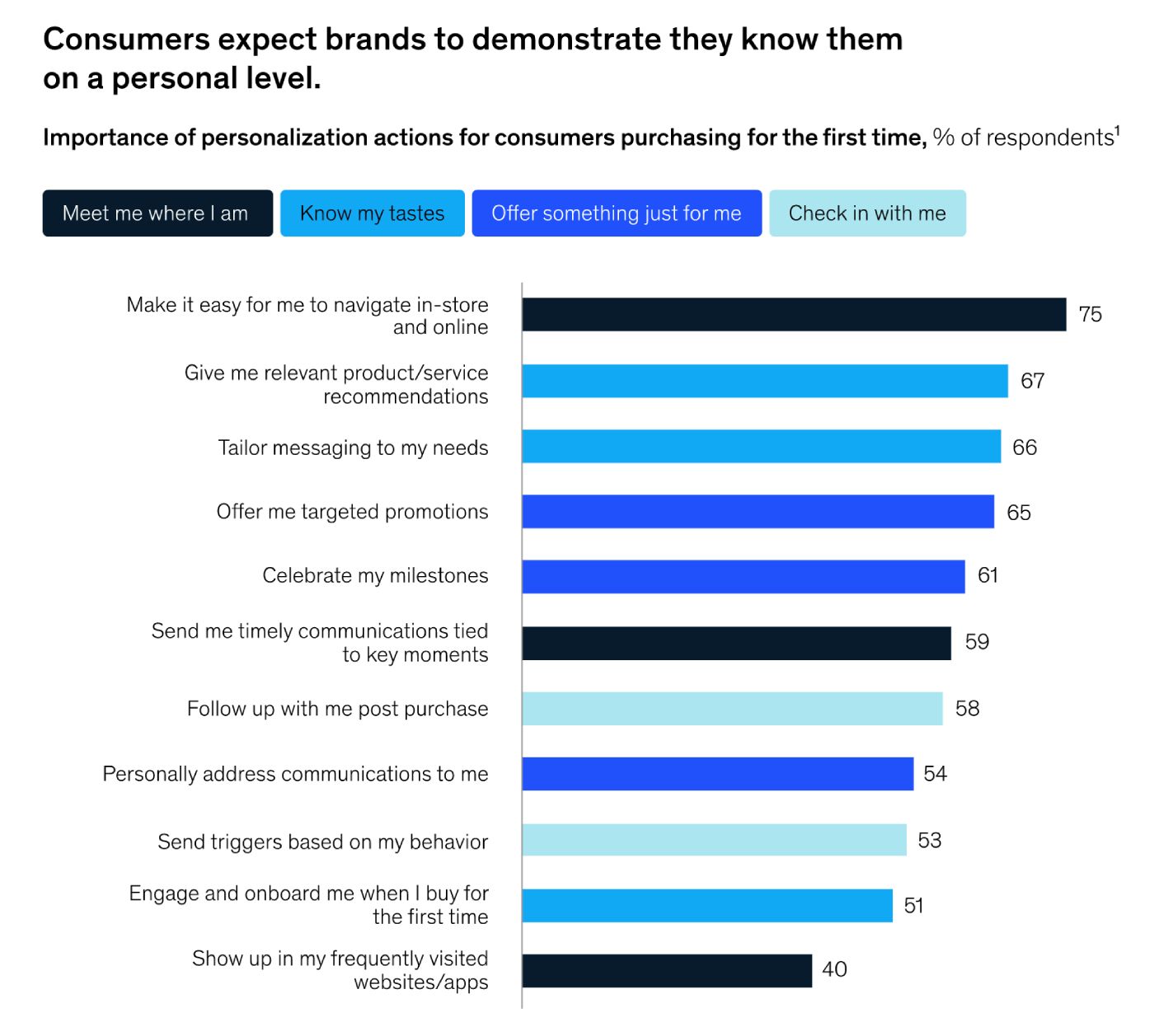
Source: McKinsey & Company
But it’s easier said than done. Surely we can all recall an experience that hit the mark, and, perhaps even more likely, one that failed miserably – from the more innocuous, like having to repeat information as you’re moved along support agents, to the more serious. With that in mind, how can you make sure you step up your personalization game in the right way?
8 steps to personalize customer experiences at scale
1. Collect first-party data
Unlock the full potential of your audience with first-party data, directly collected from Custom Bots, surveys, or sign-up forms. By establishing a direct connection with your customers, you’ll create dynamic and robust customer profiles that grow and evolve as they do. First-party data is highly reliable and dependable, and as it turns out, your customers are often happy to share it with you – a recent Salesforce study shows that 79% of customers are willing to provide relevant information about themselves in return for interactions that acknowledge and understand them, and it increases to 88% if the outcome of the data sharing is personalized offers.
By leveraging this rich, contextual data, you can gain more profound insights and trigger highly targeted messages or events based on business type, conversation subject, or actions taken. Plus, these insights can be used throughout the entire organization to create more personalized customer journeys.
2. Build a unified customer platform
To build your personalization strategy, you need the right foundation, and that foundation is only as strong as your tech stack. When you start integrating first-party data with other tools in your stack, like marketing automation platforms or CRM systems, you can gather insights from a single customer record to create a seamless, relevant customer experience.
“85% of business respondents stated that their customers prefer to have their context follow them from channel to channel”
With a unified platform across marketing, sales, and support, every conversation and interaction expands your understanding of your customers’ or prospects’ needs and helps you build a meaningful relationship with them. Your teams can get a comprehensive view of who the customer or prospect is without having to switch between platforms, which one, saves time, and two, drives customer satisfaction. In fact, 85% of business respondents stated that their customers prefer to have their context follow them from channel to channel.
3. Create user personas
So, you’ve built your unified tech stack and are collecting first-party data. Now what? With all that customer information centralized, you should be able to define segments and personas according to who they are, where they are, what feedback they’ve given, or what actions they have or haven’t taken.
By building a deep understanding of customer personas – their needs, wants, and pain points – you’re able to identify patterns and opportunities and trigger targeted messages to ensure each customer is following a specific product journey. More, you can use those insights to provide clarity and transparency on decisions to stakeholders across the organization.
4. Help customers where and when they need it
Let’s face it – most questions arise when your customers are using your product. With in-product messaging, you can reach your customers precisely when it’s most effective: when they’re already engaging with your product. It’s a convenient and time-saving solution that delivers immediate answers right at their fingertips. Say goodbye to disruptive channel-switching, and hello to a seamless and frictionless customer experience.
“In-product messaging can drive 3-4x higher engagement rates than traditional channels like email”
At Intercom, we found that in-product messaging can drive 3-4x higher engagement rates than traditional channels like email. If you want to take the most of every opportunity and make sure each interaction has the potential to drive growth, take a look at our newest guide on unlocking customer engagement with in‑product messaging.
5. Design personalized communication flows
With all the pieces of the system set up, you’re now able to trigger and orchestrate multi-channel campaigns based on where customers are in their experience with your product.
For example, for a “payment failed” event, you can trigger a personal message that informs the customer of the payment failure and encourages them to check out an article on how to update their payment method.
6. Boost personalization efforts with automation and AI
We’ve already touched on this, but it bears repeating – leveraging automation and AI is critical for delivering effective CX personalization at scale. Automated systems continuously track and analyze customer data and adjust experiences in real time, ensuring that the customer always receives the most relevant and personalized experience possible.
For example, you can set up a bot to capture custom data about your customers – like what plan they’re on, the type of query they have, and how urgent their issue is – and then route their query to the right team. This is where bots excel: answering repetitive questions such as “how do I update my billing details” quickly, reducing hold times, and quick routing to the right place. Some bots – like Intercom’s Resolution Bot – can even answer your customers’ questions before they even finish typing. This frees up your support team to handle the more complex and critical queries that need that personal touch.
7. Assemble cross-functional, customer-centric teams
A truly personalized customer experience needs to hit every stage in the customer journey, which means one team can’t single-handedly own all personalization efforts. You need cross-functional alignment between teams so that everyone is collaborating and is invested in providing the best experience possible to your customers.
“By bringing together a diverse range of skills and expertise, cross-functional teams can create a more holistic and effective approach to CX”
Imagine support helping sales identify upsell and cross-sell opportunities, customer success teams tailoring onboarding flows based on initial sales data, or product managers improving feature adoption in low-activation customers. By bringing together a diverse range of skills and expertise, cross-functional teams can create a more holistic and effective approach to CX.
8. Iterate, iterate, iterate
Last but not least, a personalized customer experience isn’t done the moment you build communication flows. Markets are always changing and customer expectations are constantly evolving, so you should too – as you keep measuring and iterating your personalization efforts, you can stay ahead of these changes and ensure that you are providing a relevant experience for your customers.
Use customer feedback, performance data, and other key performance indicators to measure which areas of your strategy aren’t delivering the desired results and tweak as you go to increase effectiveness.
Examples of great personalized CX
Recommendation algorithms
If there’s one company that popularized the notion of a personalized customer experience, it’s Amazon. By the early 2000s, the world’s largest retailer was already collecting a vast amount of data on its customers to create highly personalized experiences for each customer, including product recommendations based on purchase history and browsing behavior, and tailored discounts or promotional offers.
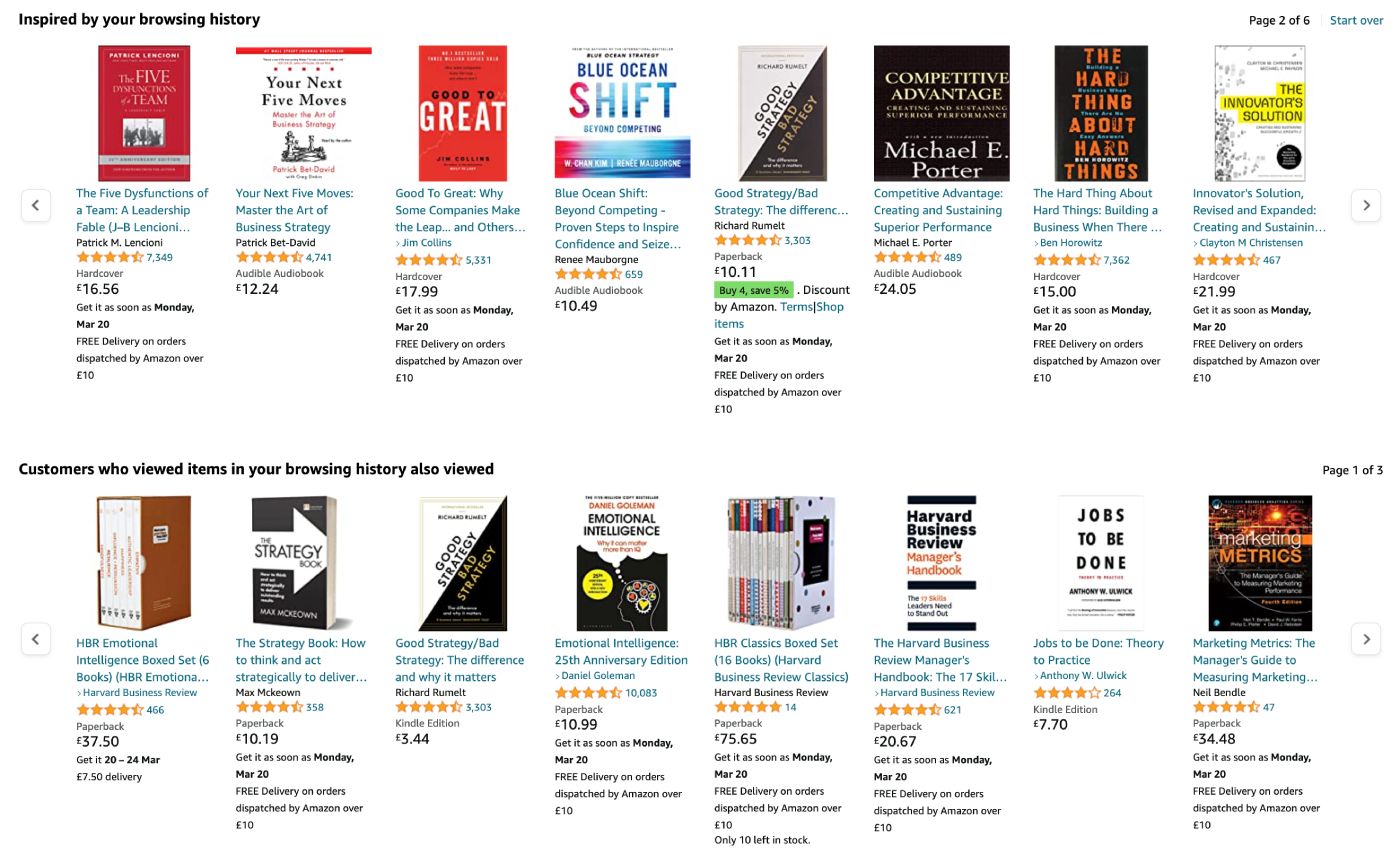
Source: Amazon
And it seems to be working: 35% of its revenue comes from its recommendation engine. When it comes to streaming giant Netflix, the numbers are even higher – 75% of what people watch on Netflix comes from recommendations. Talk about a value proposition.
Personalized marketing done right
December brings many things – chillier weather, festive decor, and the global phenomenon that is Spotify Wrapped, Spotify’s hit annual campaign that gives users an in-depth look at what they listened to that year, highlighting their listening habits, favorite artists, musical tastes, and more.
Not all data is created equal. Fortunately, Spotify was dealt a winning hand – it collects data users actually want to share. In 2020, over 90 million people engaged with the campaign. It’s fun, it’s exciting, and a great example of how companies can use personalization to create meaningful experiences for their customers.
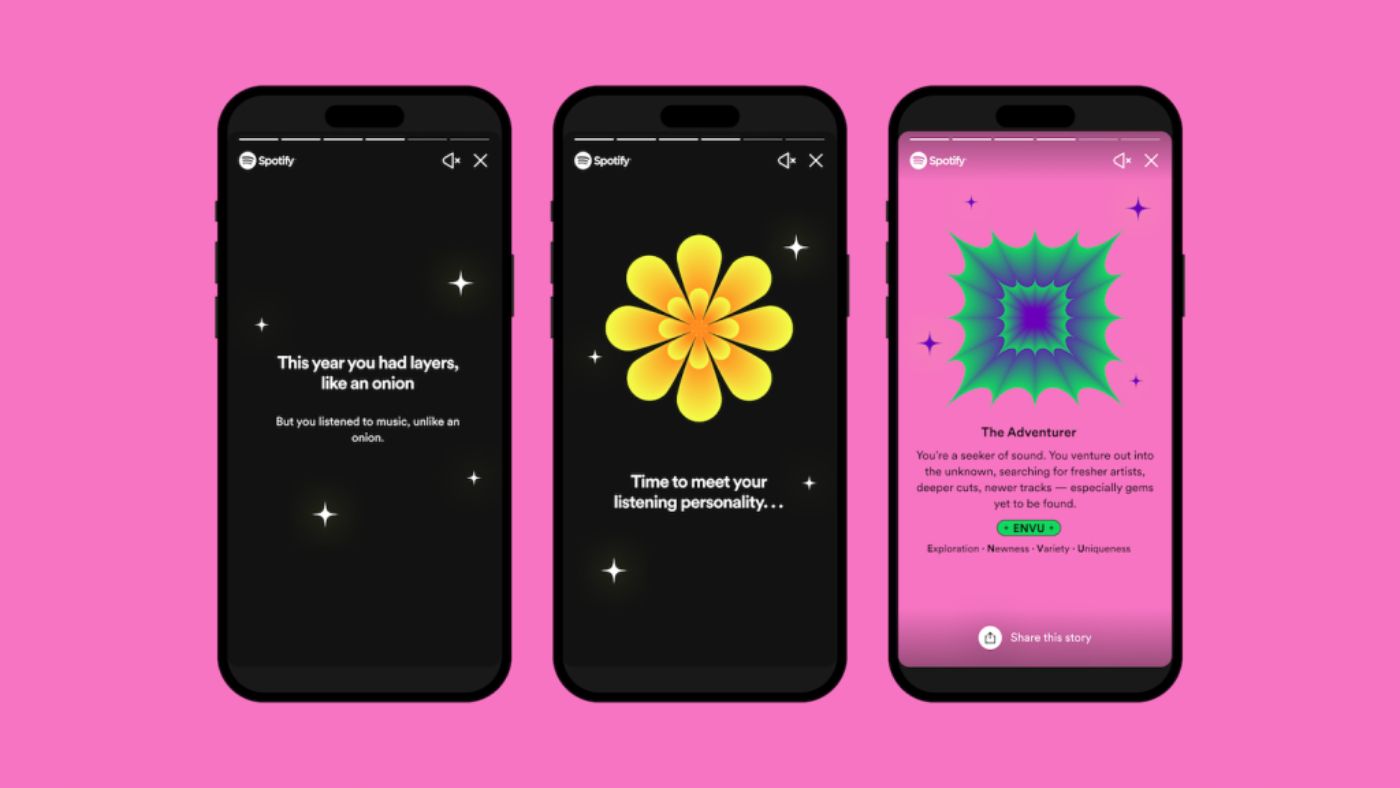
Source: Spotify
Using customer feedback to fuel growth
All-in-one doc Coda offers a highly customizable product that varies in complexity depending on the use case, which makes it difficult to provide a contextual experience. To effectively personalize experiences and cater to the specific needs of its customers, they must have a deep understanding of their user base.
One way to do that is by collecting customer feedback at the precise moment they experience something. Coda uses Intercom Surveys during the onboarding process and to measure NPS to contextualize customers’ experiences and direct actions based on real-time feedback. If someone has a not-so-great experience on their onboarding journey, Coda can get that information and step in with support in that moment of need, potentially turning a moment of frustration into a delightful experience.
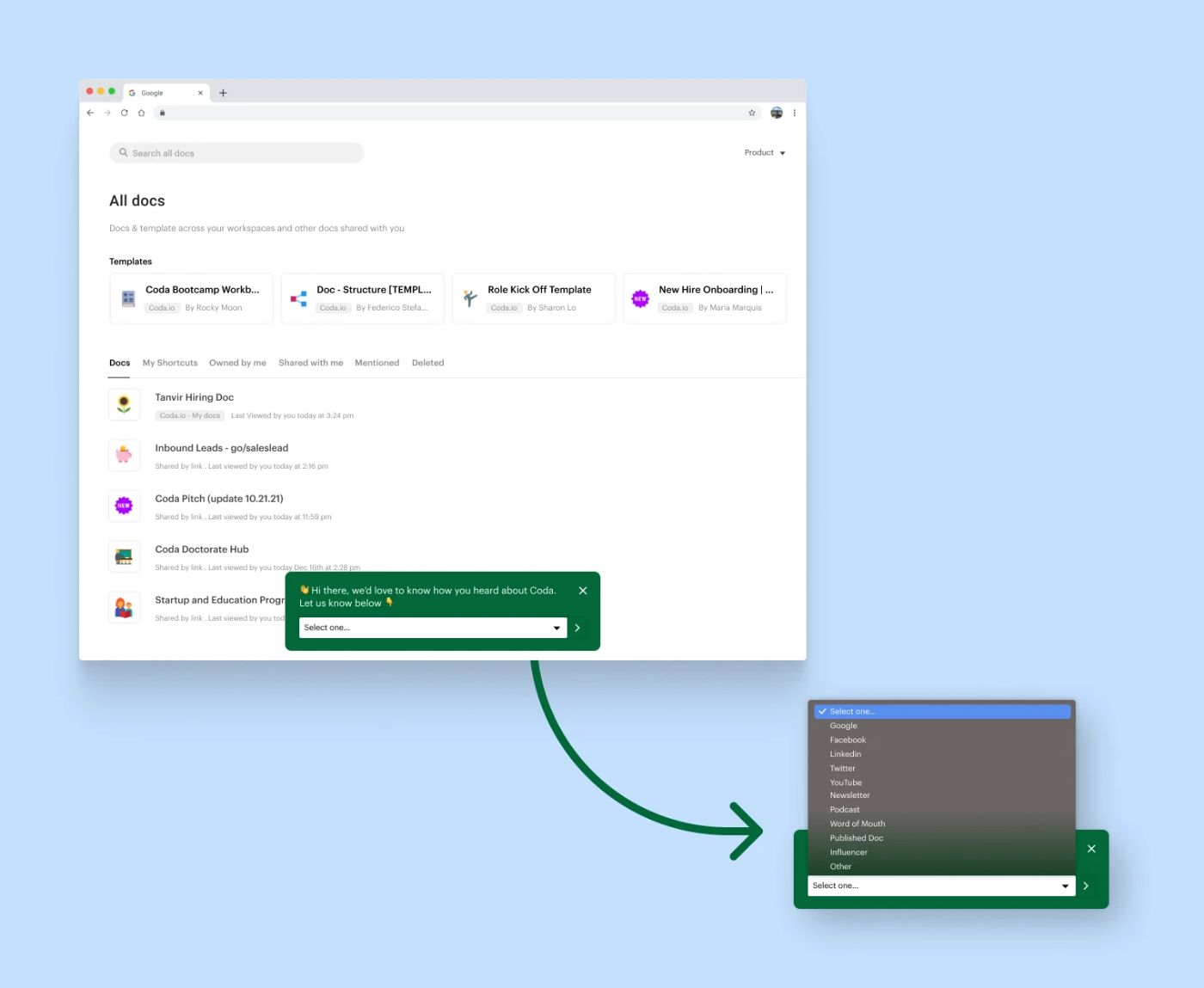
Building integrated experiences
Amplitude is a product analytics solution that specializes in customer behavioral data and digital experience. As a product-led growth organization, it needs product, marketing, and customer success collaborating in order to grow and deliver great experiences across the customer lifecycle.
At Amplitude, the customer success team uses Intercom’s visual campaign builder, Series, to create personalized messaging flows designed to set customers up for success; the support team uses the Intercom Messenger to provide real-time support and manage customer conversations through the Inbox, reducing costs and responsive times and increasing CSAT to almost 98%; the product team shares important product announcements and enables customers to submit feature requests in-product in a quick, seamless way.
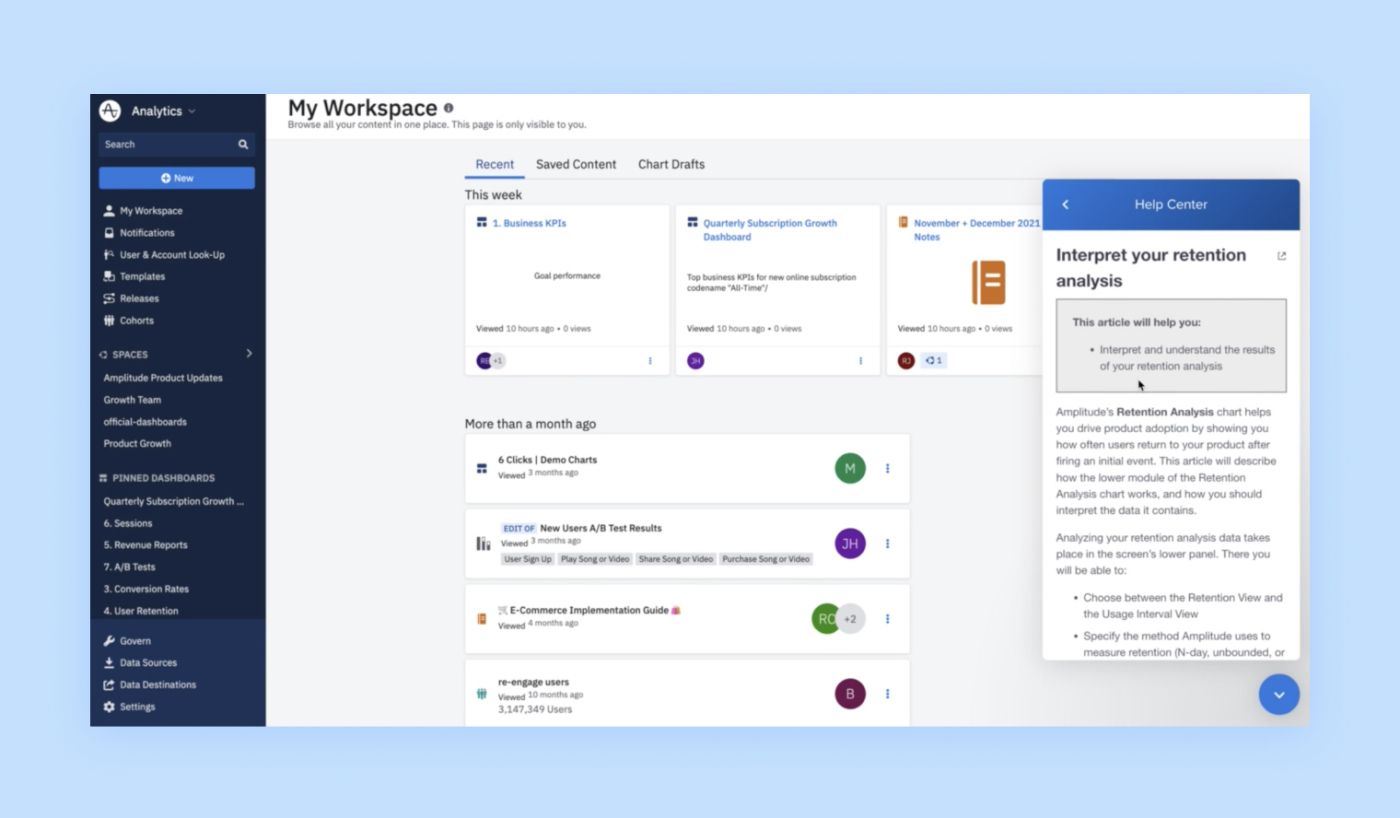
If you’re interested in supporting customers at the right moment, in the right place, feel free to ask for a demo.
What not to do
Mind you, there is such a thing as too much personalization. While it can greatly enhance the customer experience, it’s important to be aware of the risks of overstepping boundaries.
“Customers appreciate personalized experiences that are relevant and add value to their lives, but they expect brands to value their privacy, too”
In a time of growing privacy concerns, companies must be mindful of their customers’ privacy and personal information. This means being transparent about how their personal data will be used and obtaining their consent to use it for personalization purposes. It also means you’ll need to ensure that your efforts are compliant with privacy laws and regulations, such as the General Data Protection Regulation (GDPR) in Europe or the California Consumer Privacy Act (CCPA) in California.
While we’re at it, beware of anything that enters creepy territory, like tracking a customer’s location without their consent and using it to trigger ads or sharing too much personal information in a way that feels invasive. Customers appreciate personalized experiences that are relevant and add value to their lives, but they expect brands to value their privacy, too.
When done right, CX personalization can be the key to creating deeper, more meaningful relationships with customers and unlocking customer loyalty, engagement and retention, and double-digit revenue growth. Whether you’re a brick-and-mortar business, a big online retailer, or a SaaS startup, a personalized customer experience is much more than a catalyst for growth – it’s a business necessity.







